BSc Business Management: Motivation Factors & Coping Strategies
VerifiedAdded on 2023/06/15
|8
|1840
|240
Report
AI Summary
This report provides a comprehensive analysis of employee motivation within the context of a BSc (Hons) Business Management program. It delves into the meaning of motivation, exploring various factors that drive employees, including salary, promotion opportunities, and work environment. The report examines Maslow's hierarchy of needs and differentiates between intrinsic and extrinsic motivation. It further investigates the positive and negative experiences employees encounter in their job roles, such as recognition versus workplace conflicts, and proposes strategies for coping with negative factors, including reducing conflicts, providing motivation, trusting employees, and establishing boundaries. The report concludes by emphasizing the importance of a motivated workforce for organizational success and highlights the need for organizations to adopt strategies that foster employee engagement and retention. This document is available on Desklib, a platform offering a wide range of study tools and resources for students.
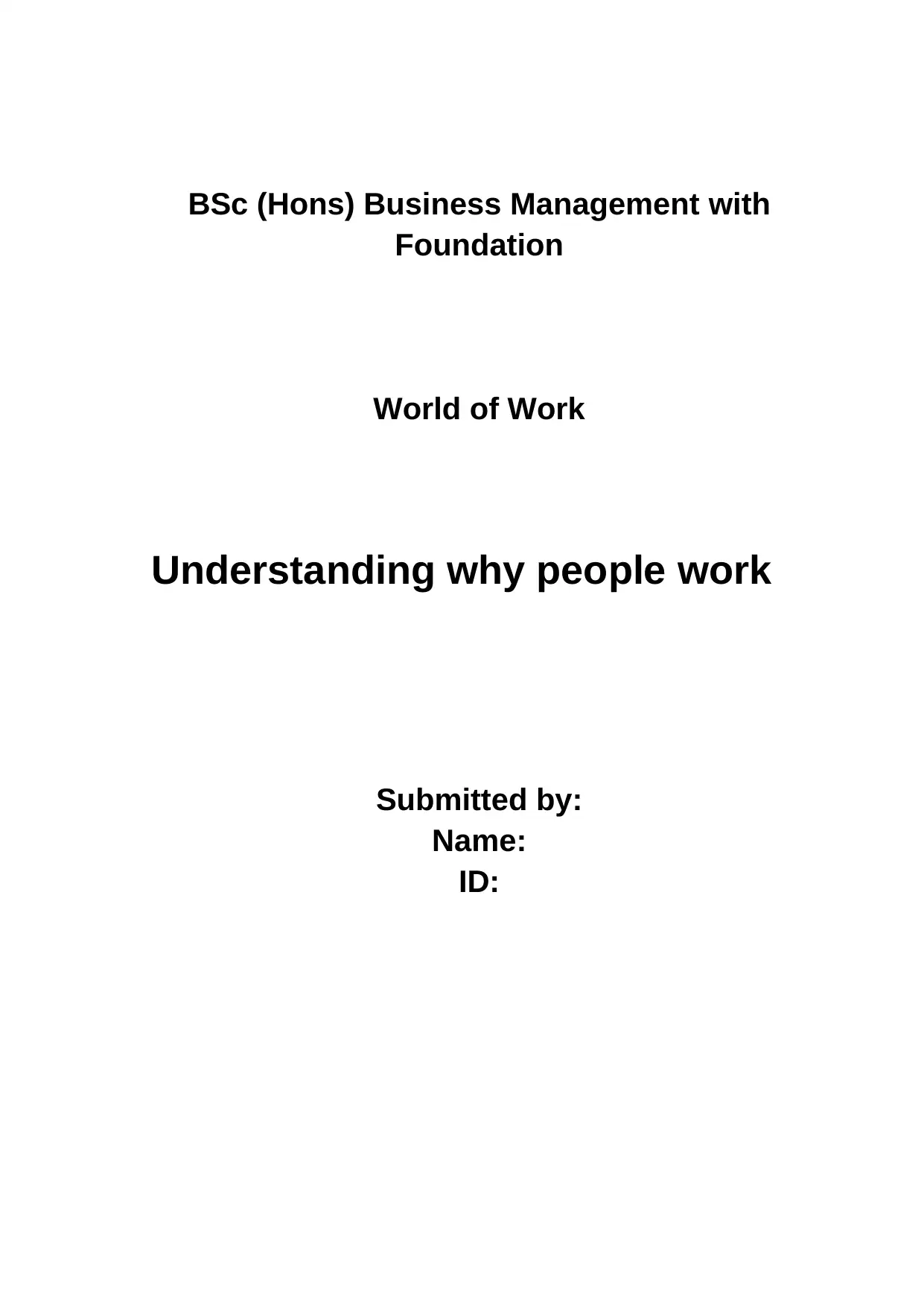
BSc (Hons) Business Management with
Foundation
World of Work
Understanding why people work
Submitted by:
Name:
ID:
Foundation
World of Work
Understanding why people work
Submitted by:
Name:
ID:
Paraphrase This Document
Need a fresh take? Get an instant paraphrase of this document with our AI Paraphraser
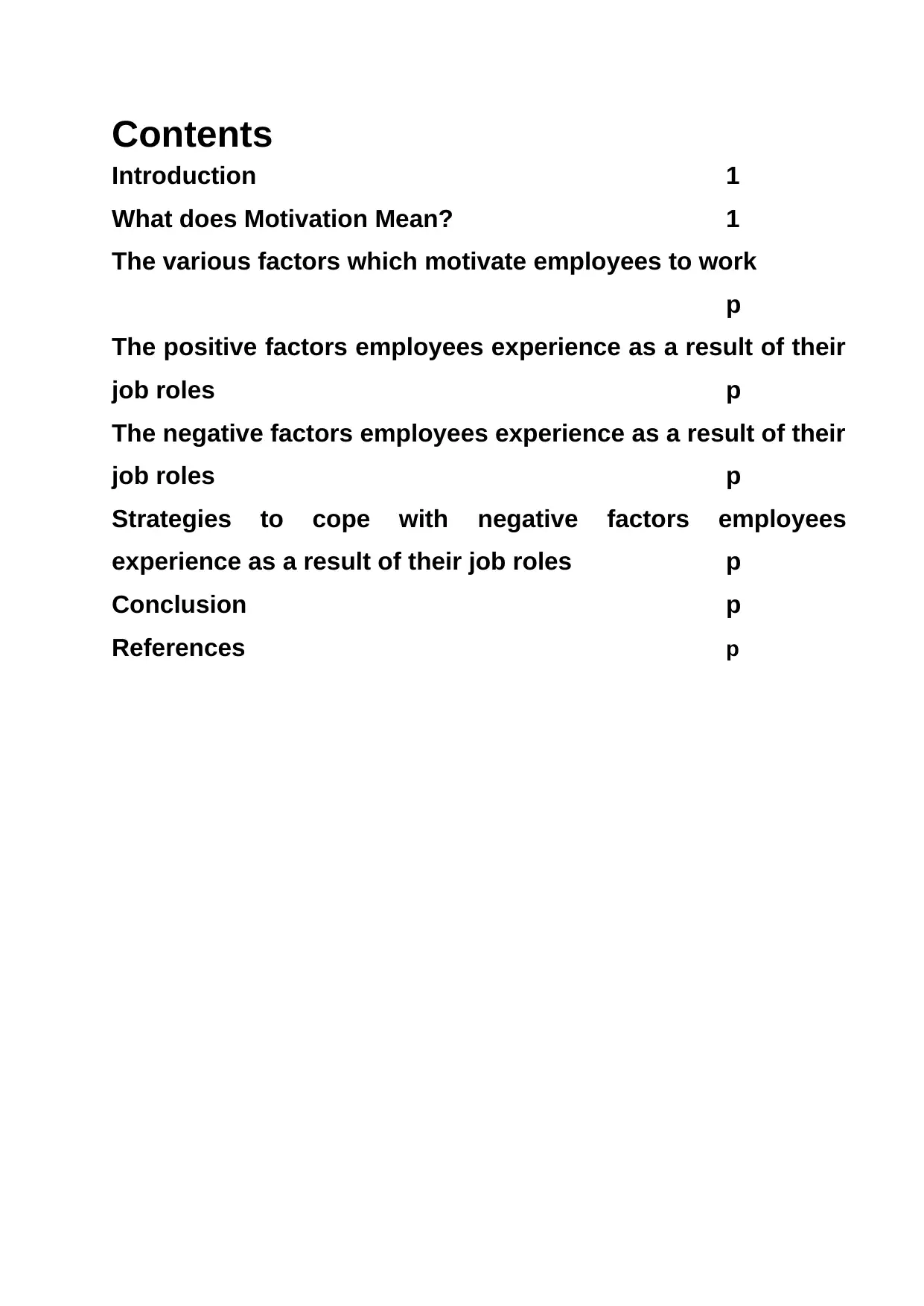
Contents
Introduction 1
What does Motivation Mean? 1
The various factors which motivate employees to work
p
The positive factors employees experience as a result of their
job roles p
The negative factors employees experience as a result of their
job roles p
Strategies to cope with negative factors employees
experience as a result of their job roles p
Conclusion p
References p
Introduction 1
What does Motivation Mean? 1
The various factors which motivate employees to work
p
The positive factors employees experience as a result of their
job roles p
The negative factors employees experience as a result of their
job roles p
Strategies to cope with negative factors employees
experience as a result of their job roles p
Conclusion p
References p
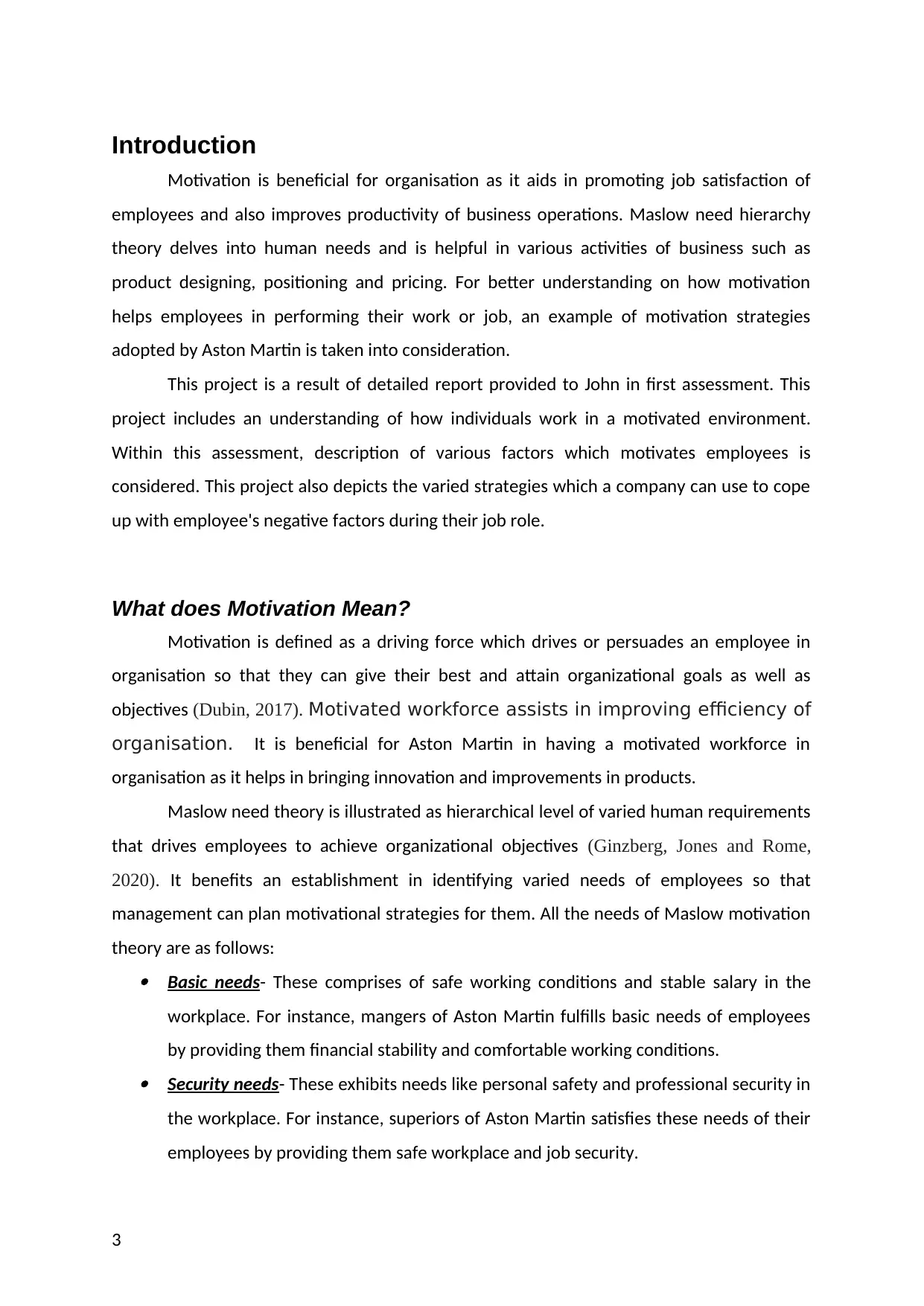
Introduction
Motivation is beneficial for organisation as it aids in promoting job satisfaction of
employees and also improves productivity of business operations. Maslow need hierarchy
theory delves into human needs and is helpful in various activities of business such as
product designing, positioning and pricing. For better understanding on how motivation
helps employees in performing their work or job, an example of motivation strategies
adopted by Aston Martin is taken into consideration.
This project is a result of detailed report provided to John in first assessment. This
project includes an understanding of how individuals work in a motivated environment.
Within this assessment, description of various factors which motivates employees is
considered. This project also depicts the varied strategies which a company can use to cope
up with employee's negative factors during their job role.
What does Motivation Mean?
Motivation is defined as a driving force which drives or persuades an employee in
organisation so that they can give their best and attain organizational goals as well as
objectives (Dubin, 2017). Motivated workforce assists in improving efficiency of
organisation. It is beneficial for Aston Martin in having a motivated workforce in
organisation as it helps in bringing innovation and improvements in products.
Maslow need theory is illustrated as hierarchical level of varied human requirements
that drives employees to achieve organizational objectives (Ginzberg, Jones and Rome,
2020). It benefits an establishment in identifying varied needs of employees so that
management can plan motivational strategies for them. All the needs of Maslow motivation
theory are as follows: Basic needs- These comprises of safe working conditions and stable salary in the
workplace. For instance, mangers of Aston Martin fulfills basic needs of employees
by providing them financial stability and comfortable working conditions. Security needs- These exhibits needs like personal safety and professional security in
the workplace. For instance, superiors of Aston Martin satisfies these needs of their
employees by providing them safe workplace and job security.
3
Motivation is beneficial for organisation as it aids in promoting job satisfaction of
employees and also improves productivity of business operations. Maslow need hierarchy
theory delves into human needs and is helpful in various activities of business such as
product designing, positioning and pricing. For better understanding on how motivation
helps employees in performing their work or job, an example of motivation strategies
adopted by Aston Martin is taken into consideration.
This project is a result of detailed report provided to John in first assessment. This
project includes an understanding of how individuals work in a motivated environment.
Within this assessment, description of various factors which motivates employees is
considered. This project also depicts the varied strategies which a company can use to cope
up with employee's negative factors during their job role.
What does Motivation Mean?
Motivation is defined as a driving force which drives or persuades an employee in
organisation so that they can give their best and attain organizational goals as well as
objectives (Dubin, 2017). Motivated workforce assists in improving efficiency of
organisation. It is beneficial for Aston Martin in having a motivated workforce in
organisation as it helps in bringing innovation and improvements in products.
Maslow need theory is illustrated as hierarchical level of varied human requirements
that drives employees to achieve organizational objectives (Ginzberg, Jones and Rome,
2020). It benefits an establishment in identifying varied needs of employees so that
management can plan motivational strategies for them. All the needs of Maslow motivation
theory are as follows: Basic needs- These comprises of safe working conditions and stable salary in the
workplace. For instance, mangers of Aston Martin fulfills basic needs of employees
by providing them financial stability and comfortable working conditions. Security needs- These exhibits needs like personal safety and professional security in
the workplace. For instance, superiors of Aston Martin satisfies these needs of their
employees by providing them safe workplace and job security.
3
⊘ This is a preview!⊘
Do you want full access?
Subscribe today to unlock all pages.

Trusted by 1+ million students worldwide
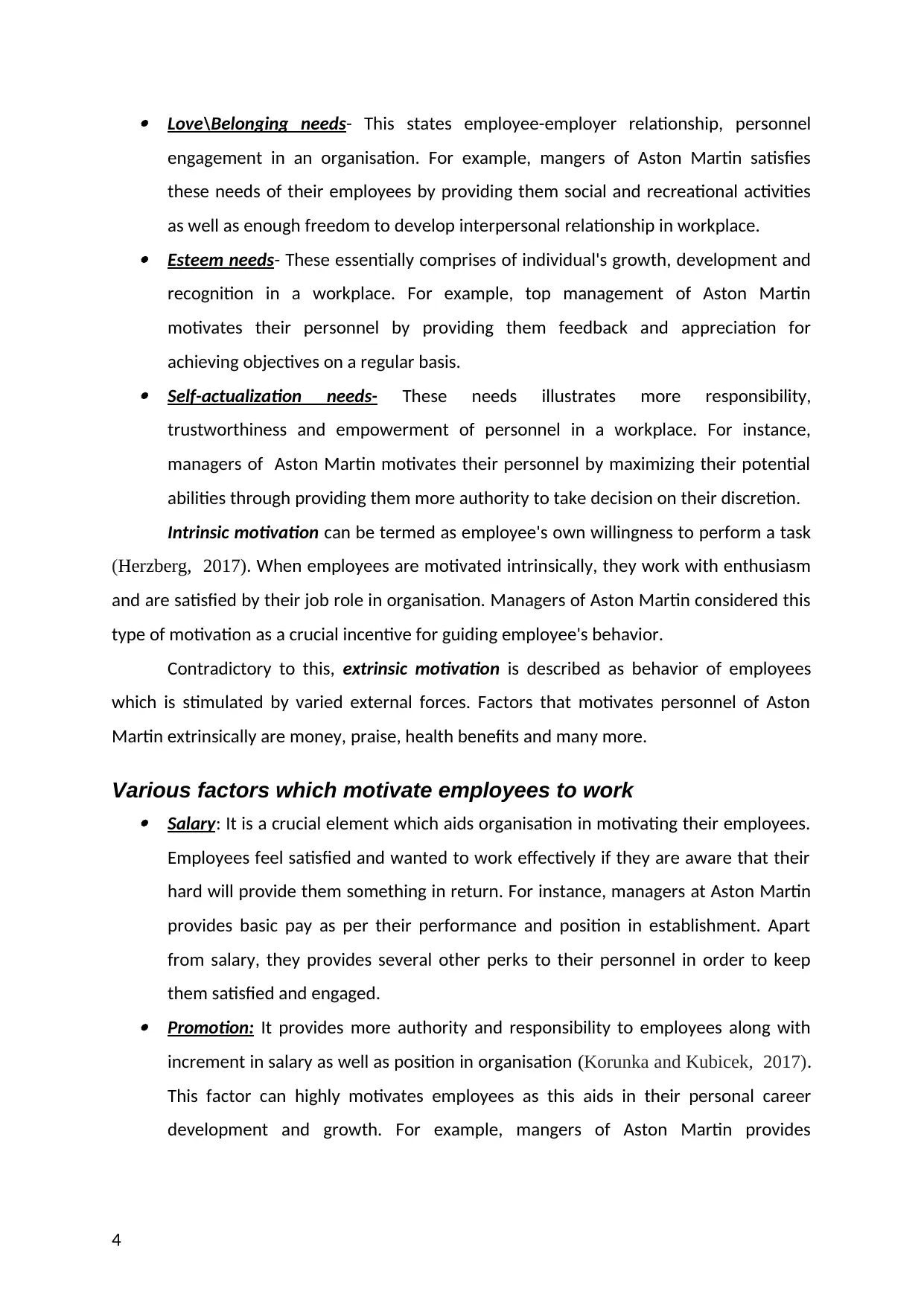
Love\Belonging needs- This states employee-employer relationship, personnel
engagement in an organisation. For example, mangers of Aston Martin satisfies
these needs of their employees by providing them social and recreational activities
as well as enough freedom to develop interpersonal relationship in workplace. Esteem needs- These essentially comprises of individual's growth, development and
recognition in a workplace. For example, top management of Aston Martin
motivates their personnel by providing them feedback and appreciation for
achieving objectives on a regular basis. Self-actualization needs- These needs illustrates more responsibility,
trustworthiness and empowerment of personnel in a workplace. For instance,
managers of Aston Martin motivates their personnel by maximizing their potential
abilities through providing them more authority to take decision on their discretion.
Intrinsic motivation can be termed as employee's own willingness to perform a task
(Herzberg, 2017). When employees are motivated intrinsically, they work with enthusiasm
and are satisfied by their job role in organisation. Managers of Aston Martin considered this
type of motivation as a crucial incentive for guiding employee's behavior.
Contradictory to this, extrinsic motivation is described as behavior of employees
which is stimulated by varied external forces. Factors that motivates personnel of Aston
Martin extrinsically are money, praise, health benefits and many more.
Various factors which motivate employees to work Salary: It is a crucial element which aids organisation in motivating their employees.
Employees feel satisfied and wanted to work effectively if they are aware that their
hard will provide them something in return. For instance, managers at Aston Martin
provides basic pay as per their performance and position in establishment. Apart
from salary, they provides several other perks to their personnel in order to keep
them satisfied and engaged. Promotion: It provides more authority and responsibility to employees along with
increment in salary as well as position in organisation (Korunka and Kubicek, 2017).
This factor can highly motivates employees as this aids in their personal career
development and growth. For example, mangers of Aston Martin provides
4
engagement in an organisation. For example, mangers of Aston Martin satisfies
these needs of their employees by providing them social and recreational activities
as well as enough freedom to develop interpersonal relationship in workplace. Esteem needs- These essentially comprises of individual's growth, development and
recognition in a workplace. For example, top management of Aston Martin
motivates their personnel by providing them feedback and appreciation for
achieving objectives on a regular basis. Self-actualization needs- These needs illustrates more responsibility,
trustworthiness and empowerment of personnel in a workplace. For instance,
managers of Aston Martin motivates their personnel by maximizing their potential
abilities through providing them more authority to take decision on their discretion.
Intrinsic motivation can be termed as employee's own willingness to perform a task
(Herzberg, 2017). When employees are motivated intrinsically, they work with enthusiasm
and are satisfied by their job role in organisation. Managers of Aston Martin considered this
type of motivation as a crucial incentive for guiding employee's behavior.
Contradictory to this, extrinsic motivation is described as behavior of employees
which is stimulated by varied external forces. Factors that motivates personnel of Aston
Martin extrinsically are money, praise, health benefits and many more.
Various factors which motivate employees to work Salary: It is a crucial element which aids organisation in motivating their employees.
Employees feel satisfied and wanted to work effectively if they are aware that their
hard will provide them something in return. For instance, managers at Aston Martin
provides basic pay as per their performance and position in establishment. Apart
from salary, they provides several other perks to their personnel in order to keep
them satisfied and engaged. Promotion: It provides more authority and responsibility to employees along with
increment in salary as well as position in organisation (Korunka and Kubicek, 2017).
This factor can highly motivates employees as this aids in their personal career
development and growth. For example, mangers of Aston Martin provides
4
Paraphrase This Document
Need a fresh take? Get an instant paraphrase of this document with our AI Paraphraser
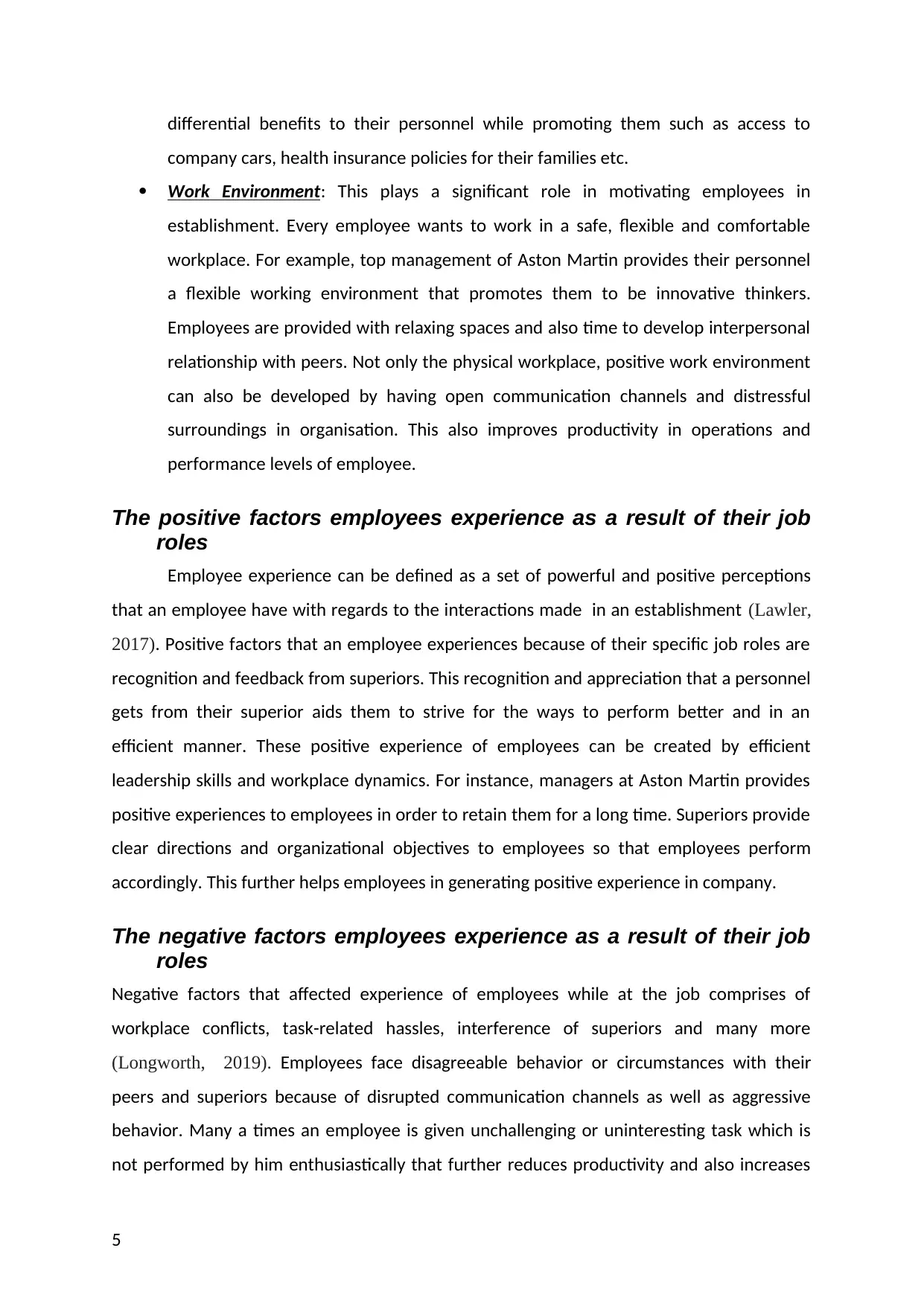
differential benefits to their personnel while promoting them such as access to
company cars, health insurance policies for their families etc.
Work Environment: This plays a significant role in motivating employees in
establishment. Every employee wants to work in a safe, flexible and comfortable
workplace. For example, top management of Aston Martin provides their personnel
a flexible working environment that promotes them to be innovative thinkers.
Employees are provided with relaxing spaces and also time to develop interpersonal
relationship with peers. Not only the physical workplace, positive work environment
can also be developed by having open communication channels and distressful
surroundings in organisation. This also improves productivity in operations and
performance levels of employee.
The positive factors employees experience as a result of their job
roles
Employee experience can be defined as a set of powerful and positive perceptions
that an employee have with regards to the interactions made in an establishment (Lawler,
2017). Positive factors that an employee experiences because of their specific job roles are
recognition and feedback from superiors. This recognition and appreciation that a personnel
gets from their superior aids them to strive for the ways to perform better and in an
efficient manner. These positive experience of employees can be created by efficient
leadership skills and workplace dynamics. For instance, managers at Aston Martin provides
positive experiences to employees in order to retain them for a long time. Superiors provide
clear directions and organizational objectives to employees so that employees perform
accordingly. This further helps employees in generating positive experience in company.
The negative factors employees experience as a result of their job
roles
Negative factors that affected experience of employees while at the job comprises of
workplace conflicts, task-related hassles, interference of superiors and many more
(Longworth, 2019). Employees face disagreeable behavior or circumstances with their
peers and superiors because of disrupted communication channels as well as aggressive
behavior. Many a times an employee is given unchallenging or uninteresting task which is
not performed by him enthusiastically that further reduces productivity and also increases
5
company cars, health insurance policies for their families etc.
Work Environment: This plays a significant role in motivating employees in
establishment. Every employee wants to work in a safe, flexible and comfortable
workplace. For example, top management of Aston Martin provides their personnel
a flexible working environment that promotes them to be innovative thinkers.
Employees are provided with relaxing spaces and also time to develop interpersonal
relationship with peers. Not only the physical workplace, positive work environment
can also be developed by having open communication channels and distressful
surroundings in organisation. This also improves productivity in operations and
performance levels of employee.
The positive factors employees experience as a result of their job
roles
Employee experience can be defined as a set of powerful and positive perceptions
that an employee have with regards to the interactions made in an establishment (Lawler,
2017). Positive factors that an employee experiences because of their specific job roles are
recognition and feedback from superiors. This recognition and appreciation that a personnel
gets from their superior aids them to strive for the ways to perform better and in an
efficient manner. These positive experience of employees can be created by efficient
leadership skills and workplace dynamics. For instance, managers at Aston Martin provides
positive experiences to employees in order to retain them for a long time. Superiors provide
clear directions and organizational objectives to employees so that employees perform
accordingly. This further helps employees in generating positive experience in company.
The negative factors employees experience as a result of their job
roles
Negative factors that affected experience of employees while at the job comprises of
workplace conflicts, task-related hassles, interference of superiors and many more
(Longworth, 2019). Employees face disagreeable behavior or circumstances with their
peers and superiors because of disrupted communication channels as well as aggressive
behavior. Many a times an employee is given unchallenging or uninteresting task which is
not performed by him enthusiastically that further reduces productivity and also increases
5
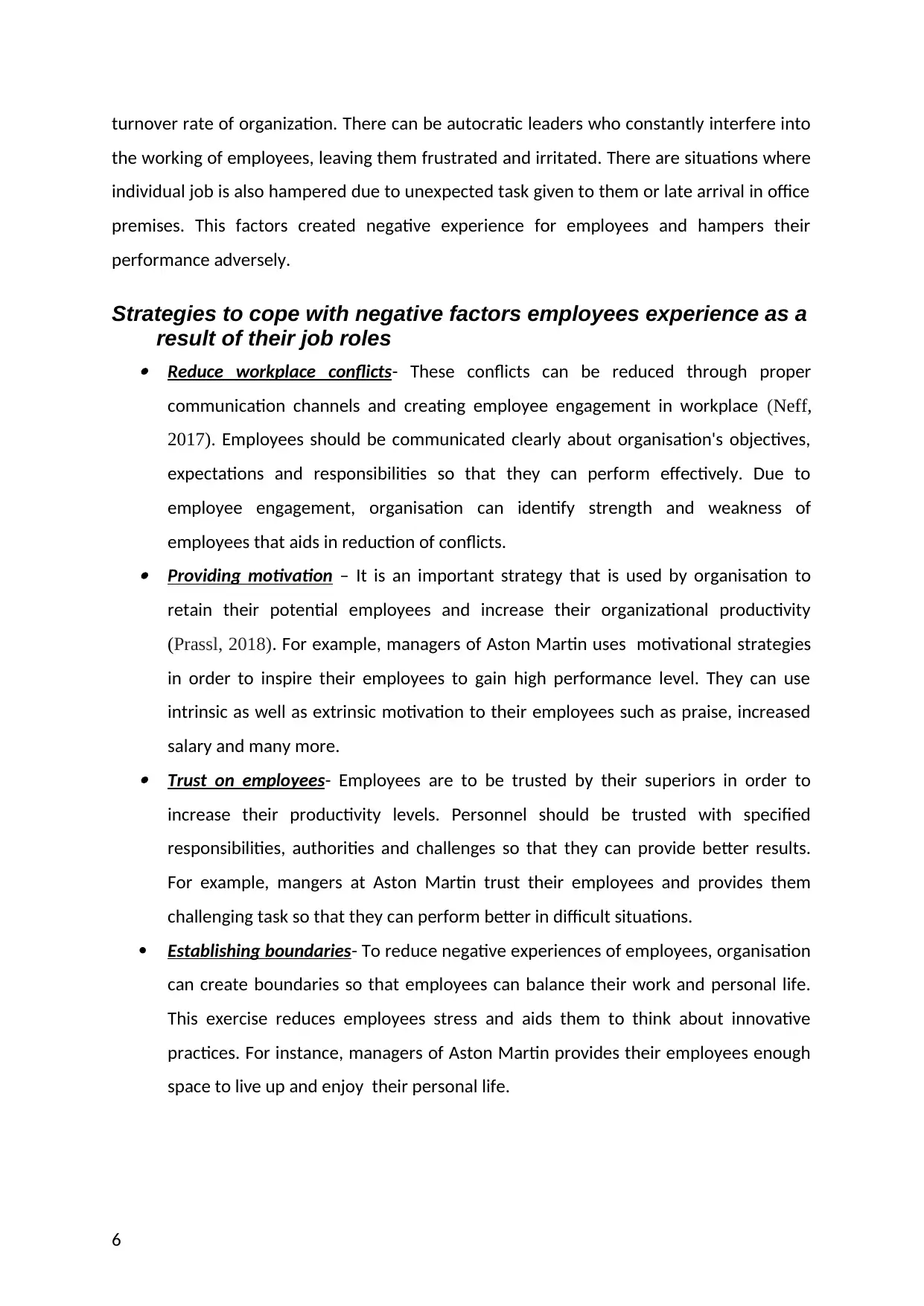
turnover rate of organization. There can be autocratic leaders who constantly interfere into
the working of employees, leaving them frustrated and irritated. There are situations where
individual job is also hampered due to unexpected task given to them or late arrival in office
premises. This factors created negative experience for employees and hampers their
performance adversely.
Strategies to cope with negative factors employees experience as a
result of their job roles Reduce workplace conflicts- These conflicts can be reduced through proper
communication channels and creating employee engagement in workplace (Neff,
2017). Employees should be communicated clearly about organisation's objectives,
expectations and responsibilities so that they can perform effectively. Due to
employee engagement, organisation can identify strength and weakness of
employees that aids in reduction of conflicts. Providing motivation – It is an important strategy that is used by organisation to
retain their potential employees and increase their organizational productivity
(Prassl, 2018). For example, managers of Aston Martin uses motivational strategies
in order to inspire their employees to gain high performance level. They can use
intrinsic as well as extrinsic motivation to their employees such as praise, increased
salary and many more. Trust on employees- Employees are to be trusted by their superiors in order to
increase their productivity levels. Personnel should be trusted with specified
responsibilities, authorities and challenges so that they can provide better results.
For example, mangers at Aston Martin trust their employees and provides them
challenging task so that they can perform better in difficult situations.
Establishing boundaries- To reduce negative experiences of employees, organisation
can create boundaries so that employees can balance their work and personal life.
This exercise reduces employees stress and aids them to think about innovative
practices. For instance, managers of Aston Martin provides their employees enough
space to live up and enjoy their personal life.
6
the working of employees, leaving them frustrated and irritated. There are situations where
individual job is also hampered due to unexpected task given to them or late arrival in office
premises. This factors created negative experience for employees and hampers their
performance adversely.
Strategies to cope with negative factors employees experience as a
result of their job roles Reduce workplace conflicts- These conflicts can be reduced through proper
communication channels and creating employee engagement in workplace (Neff,
2017). Employees should be communicated clearly about organisation's objectives,
expectations and responsibilities so that they can perform effectively. Due to
employee engagement, organisation can identify strength and weakness of
employees that aids in reduction of conflicts. Providing motivation – It is an important strategy that is used by organisation to
retain their potential employees and increase their organizational productivity
(Prassl, 2018). For example, managers of Aston Martin uses motivational strategies
in order to inspire their employees to gain high performance level. They can use
intrinsic as well as extrinsic motivation to their employees such as praise, increased
salary and many more. Trust on employees- Employees are to be trusted by their superiors in order to
increase their productivity levels. Personnel should be trusted with specified
responsibilities, authorities and challenges so that they can provide better results.
For example, mangers at Aston Martin trust their employees and provides them
challenging task so that they can perform better in difficult situations.
Establishing boundaries- To reduce negative experiences of employees, organisation
can create boundaries so that employees can balance their work and personal life.
This exercise reduces employees stress and aids them to think about innovative
practices. For instance, managers of Aston Martin provides their employees enough
space to live up and enjoy their personal life.
6
⊘ This is a preview!⊘
Do you want full access?
Subscribe today to unlock all pages.

Trusted by 1+ million students worldwide
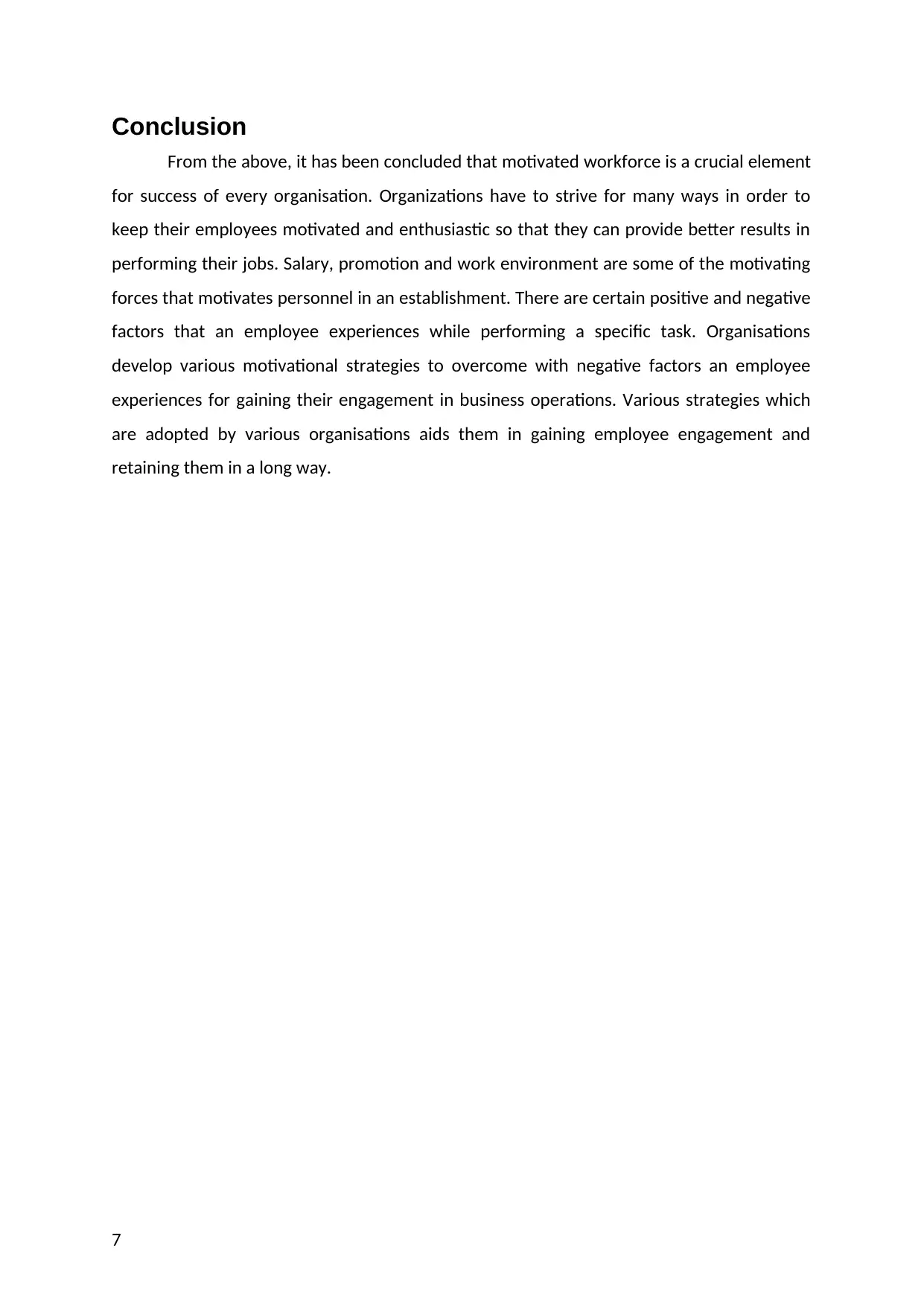
Conclusion
From the above, it has been concluded that motivated workforce is a crucial element
for success of every organisation. Organizations have to strive for many ways in order to
keep their employees motivated and enthusiastic so that they can provide better results in
performing their jobs. Salary, promotion and work environment are some of the motivating
forces that motivates personnel in an establishment. There are certain positive and negative
factors that an employee experiences while performing a specific task. Organisations
develop various motivational strategies to overcome with negative factors an employee
experiences for gaining their engagement in business operations. Various strategies which
are adopted by various organisations aids them in gaining employee engagement and
retaining them in a long way.
7
From the above, it has been concluded that motivated workforce is a crucial element
for success of every organisation. Organizations have to strive for many ways in order to
keep their employees motivated and enthusiastic so that they can provide better results in
performing their jobs. Salary, promotion and work environment are some of the motivating
forces that motivates personnel in an establishment. There are certain positive and negative
factors that an employee experiences while performing a specific task. Organisations
develop various motivational strategies to overcome with negative factors an employee
experiences for gaining their engagement in business operations. Various strategies which
are adopted by various organisations aids them in gaining employee engagement and
retaining them in a long way.
7
Paraphrase This Document
Need a fresh take? Get an instant paraphrase of this document with our AI Paraphraser
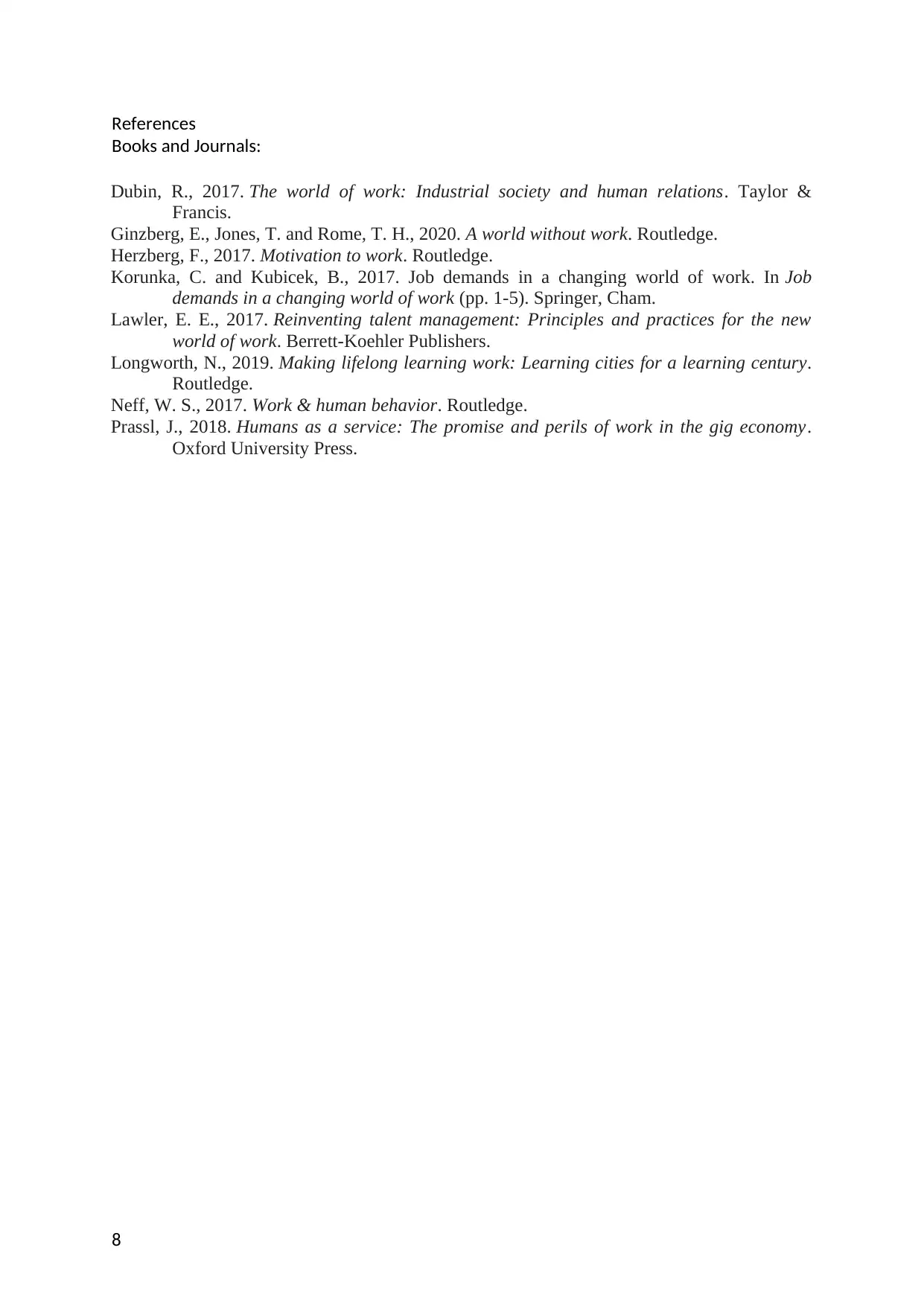
References
Books and Journals:
Dubin, R., 2017. The world of work: Industrial society and human relations. Taylor &
Francis.
Ginzberg, E., Jones, T. and Rome, T. H., 2020. A world without work. Routledge.
Herzberg, F., 2017. Motivation to work. Routledge.
Korunka, C. and Kubicek, B., 2017. Job demands in a changing world of work. In Job
demands in a changing world of work (pp. 1-5). Springer, Cham.
Lawler, E. E., 2017. Reinventing talent management: Principles and practices for the new
world of work. Berrett-Koehler Publishers.
Longworth, N., 2019. Making lifelong learning work: Learning cities for a learning century.
Routledge.
Neff, W. S., 2017. Work & human behavior. Routledge.
Prassl, J., 2018. Humans as a service: The promise and perils of work in the gig economy.
Oxford University Press.
8
Books and Journals:
Dubin, R., 2017. The world of work: Industrial society and human relations. Taylor &
Francis.
Ginzberg, E., Jones, T. and Rome, T. H., 2020. A world without work. Routledge.
Herzberg, F., 2017. Motivation to work. Routledge.
Korunka, C. and Kubicek, B., 2017. Job demands in a changing world of work. In Job
demands in a changing world of work (pp. 1-5). Springer, Cham.
Lawler, E. E., 2017. Reinventing talent management: Principles and practices for the new
world of work. Berrett-Koehler Publishers.
Longworth, N., 2019. Making lifelong learning work: Learning cities for a learning century.
Routledge.
Neff, W. S., 2017. Work & human behavior. Routledge.
Prassl, J., 2018. Humans as a service: The promise and perils of work in the gig economy.
Oxford University Press.
8
1 out of 8
Related Documents
Your All-in-One AI-Powered Toolkit for Academic Success.
+13062052269
info@desklib.com
Available 24*7 on WhatsApp / Email
![[object Object]](/_next/static/media/star-bottom.7253800d.svg)
Unlock your academic potential
Copyright © 2020–2025 A2Z Services. All Rights Reserved. Developed and managed by ZUCOL.

